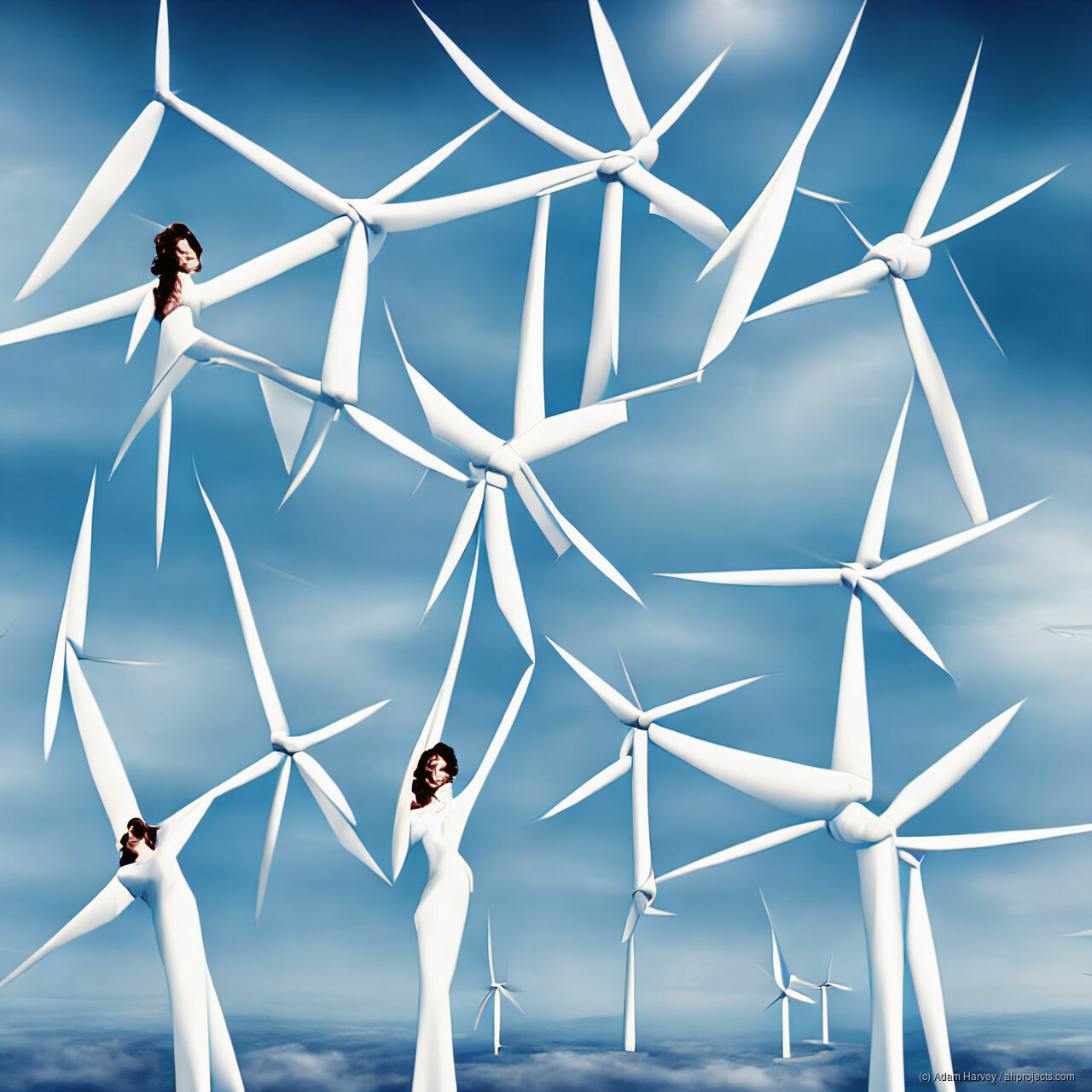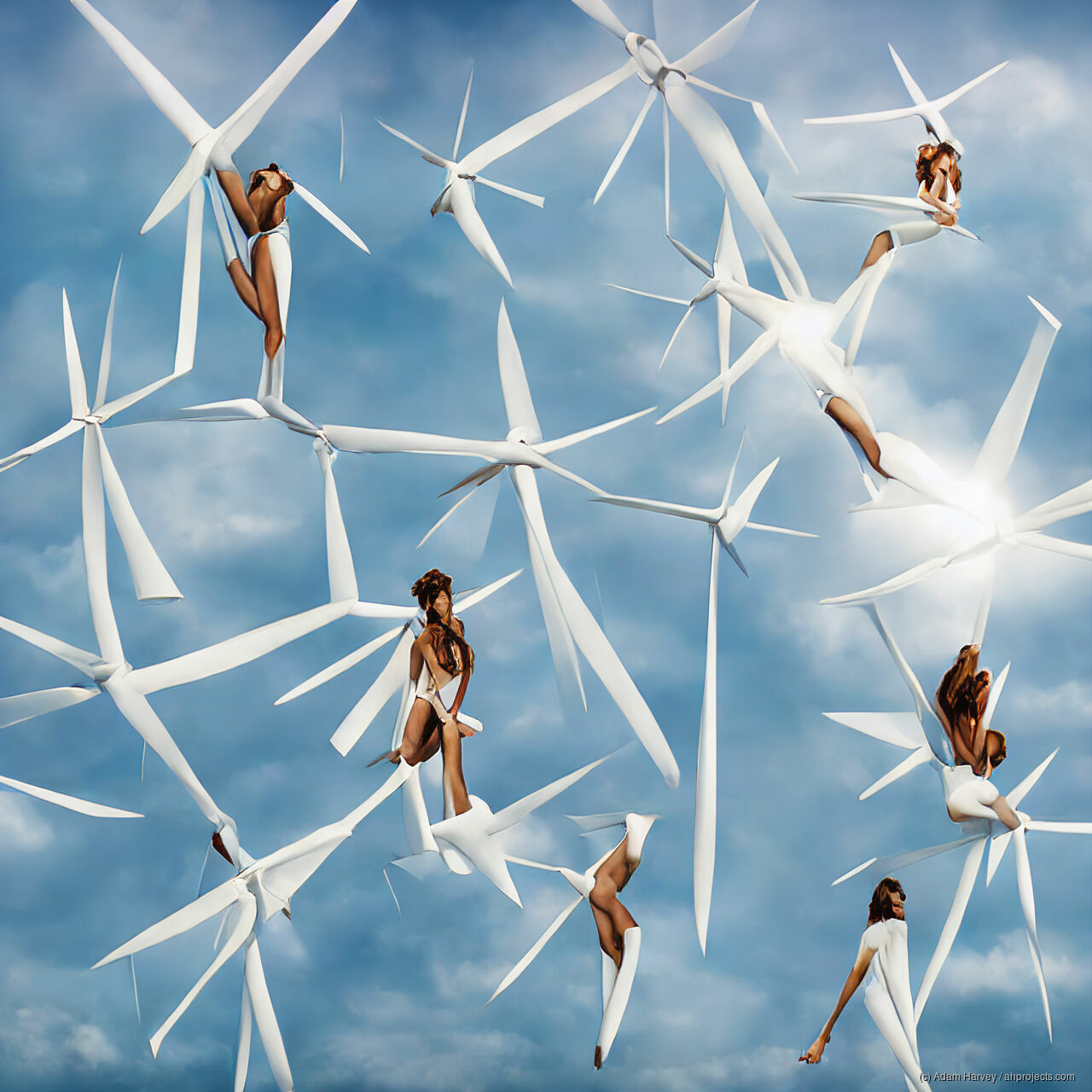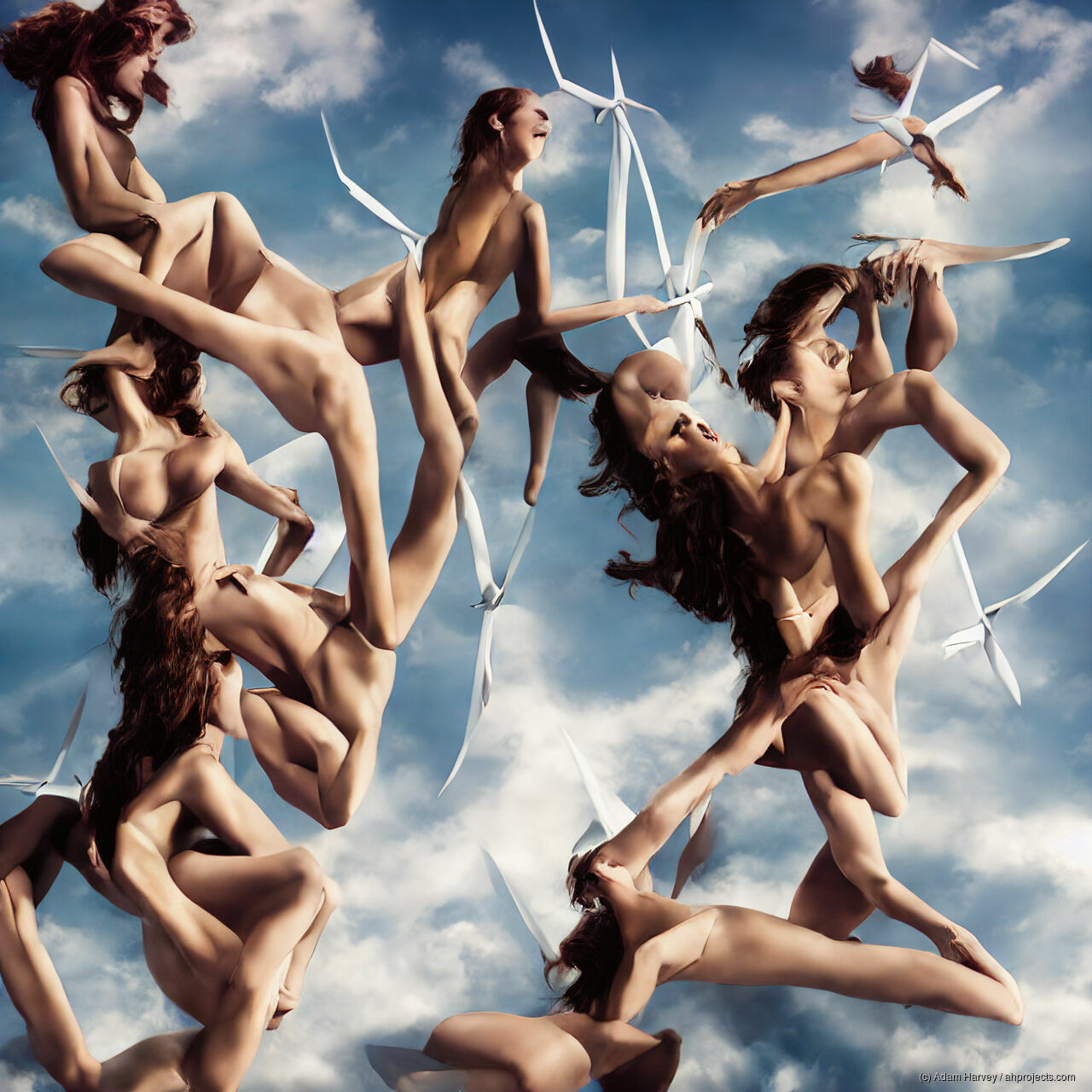
Jevons’s Parada (Circular Diffusion) N°2-5. © Adam Harvey 2022
Jevon’s Paradox (Circular Diffusion) #
GANs and generative AI enable groundbreaking new approaches to visual communication. They automate artistic production and auto-complete visual concepts, transforming low-dimensional ideas into high-resolution imagery. But they also create new concerns ranging from computational plagiarism to excessive energy usage. Circular Diffusion is a reflection on the perils and possibilities of generative AI technologies and their unavoidable relationship to energy and propaganda. The title is a reference to newly developed AI diffusion algorithms, their power to automate the production of awe-inspiring imagery, and the circular logic of extrapolation.
AI is often considered a hopeful technology with unlimited problem solving capabilities. But new solutions create new problems. When GANs and Generative AI are applied to climate change they produce non-scientific output cloaked in scientific language. The “ science behind the project” is often not actual climate science, but merely data science built on the theory that “anything goes,”1, in effect amplifying misinformation and degrading trust in media.
When you have a theory there are two kinds of questions you have to ask. Why are things this way? Why are things not that way? If you don’t get the second question you’ve done nothing.
Not being able to answer these questions is part of the fun of Generative AI. But it is a circular experience. Images are generated to learn how images are generated. The past is represented through new algorithmic lenses, but is still the past. No new knowledge is created. “[W]here GANs serve as a medium, what there is to know is what is already known.”2
Further, using generative AI to address climate change can multiply the existing problem: mitigating climate change means reducing energy, but developing AI requires vast amounts of it.
It could seem that GANs and Generative AI are the opposite of what the future needs: energy intensive fake-image generators that contribute negatively to science. Almost. Their true value is not science but propaganda, or rather their ability automate the visual layer of communication in cybernetic systems. This is more significant than the JPEG compression algorithm was to photographs or the MP3 compression algorithms was for the propagation of music. GANs just work in reverse, expanding compressed neural potential into formatted visual kinetics. In this way GANs and Generative AI contribute a new layer of algorithmic visual communication infrastructure: the power to expand low-dimensional concepts into higher-dimensional representations.
The images in Circular Diffusion refer back to the energy waste of their generative production by using this very system to “diffuse” and propagate an ascendant and sustainable version of itself by cloaking the context in the latent space of classical art and greenwashing stock imagery.
Generative AI is compelling, but if its reward function doesn’t optimize for global goals the results are doomed to converge towards a quixotic descent.
Each image from the paneled artwork above is shown in more detail below. For exhibitions, the work is presented as a 2x2 grid (120 x 120cm total) emphasizing a circular clockwise movement of energy being transformed into art promoting the energy systems used to generate the energy-driven art. It is not art but a meta statement about images claiming to be art, while serving the higher purpose of promoting the underlying system, much like the reference to transcendent classical art composition of each image in this work.

Circular Diffusion N°2. 60 x 60 cm photographic print. © Adam Harvey 2022

Circular Diffusion N°3. 60 x 60 cm photographic print. © Adam Harvey 2022

Circular Diffusion N°4. 60 x 60 cm photographic print. © Adam Harvey 2022

Circular Diffusion N°5. 60 x 60 cm photographic print. © Adam Harvey 2022
Text and artwork: © Adam Harvey. Created December 2021 - August 2022.
Credits #
Concept, software development, image processing, and text: Adam Harvey
Commissioned by The New Real Observatory, developed between December 2021 - August 2022, and first exhibited the Ars Electronica festival 2022 in Linz, Austria.
The New Real Observatory is part of The New Real, a partnership between University of Edinburgh, Edinburgh’s Festivals and The Alan Turing Institute. Featured artists Adam Harvey, Inés Cámara Leret, Keziah MacNeill, Alex Fefegha. Funded by the Arts and Humanities Research Council (AHRC) - UK Research and Innovation (UKRI), Towards Turing 2.0 and Engineering and Physical Sciences Research Council (EPSRC)
The New Real Team:
- Role 1: Principal Investigator and Project Director: Drew Hemment
- Role 2: Co-Investigator and Lead Designer: Matjaz Vidmar
- Role 3: Artists: Adam Harvey, Inés Cámara Leret, Keziah MacNeill, Alex Fefegha, Alan Butler
- Role 4: Data Science Lead: Sohan Seth
- Role 5: Data Science Post-Doctoral Research Assistant: Daga Panas
- Role 7: Research Engineer: Mario Antonioletti, Edinburgh Parallel Computing Centre
- Role 8: Research Engineer: Evan Morgan, Design Informatics
- Role 9: Creative Producer/Project Manager: Miriam Walsh
- Role 10: Research Assistant in Ethnography of Festival Experience: Julie Ann Fooshee
- Role 11: Research Assistant in Human Computer Interaction: David Sarmiento
- Role 12: Design Research Assistant: Keili Koppel
- Role 13: Administration and Communications Coordinator: Sarah Mackinnon
- Role 14: XAI Research and Algorithm Design Advisor: Vaishak Belle
- Role 15: Creative Coding and Consultation: Mickey van Olst, Frank Reitberger
- Role 16: Creative Technology Consultation: Aurélien Krieger
- Role 17: Festival partners: Ars Electronica
Additional thanks to the developers and maintainers of all the open-source software used in this project including CompVis diffusion software, GIMP image processing, LibreOffice (for project management), Python core software application development, and Ubuntu operating system.
MLST #78 - Prof. NOAM CHOMSKY (Special Edition). https://podcasts.apple.com/us/podcast/mlst-78-prof-noam-chomsky-special-edition/id1510472996? ↩︎
Offert, Fabian. “Latent Deep Space: Generative Adversarial Networks (GANs) in the Sciences.” Media+Environment. Dec. 22, 2021. https://mediaenviron.org/article/29905-latent-deep-space-generative-adversarial-networks-gans-in-the-sciences ↩︎